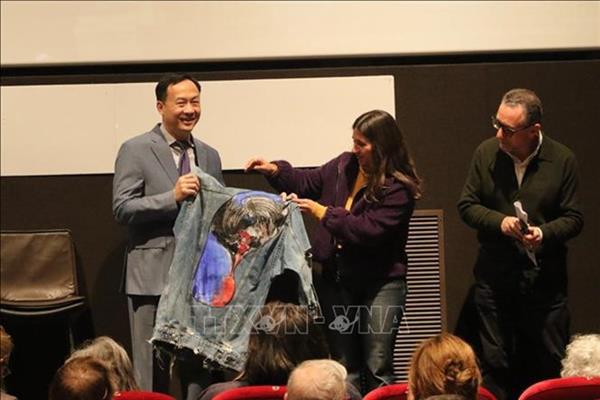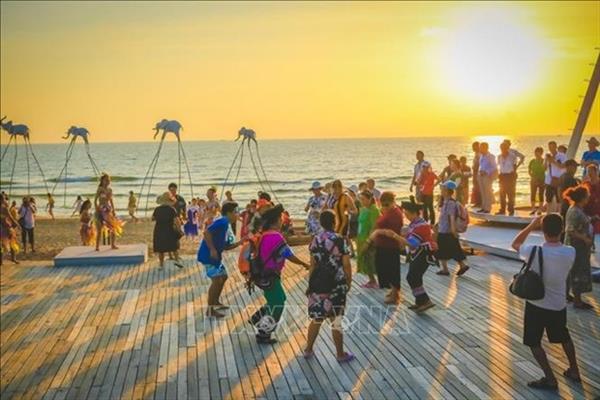Hanoi, May 2 (VNA) - A teenager's passion for stone lions has given them an imposing global presence via a wesbite on which he uploads photographs that can be seen in three dimensions.
Creators of traditional fine arts throughout the country can satisfy their hunger for images of Vietnamese temple and pagoda nghe (kylin/lions) lions at a unique website set up by Hanoi-based teenager Nguyen Tri Quang.
Quang's father, who is himself a sculptor of traditional mythical animals, accompanied his son on many of his photographic journeys.
Through his www.vr3d.vn website, people can flip through thousands of photos of the animals depicted in statues at pagodas and temples throughout northern and central regions.
With one click, stone sculptures can be viewed in three dimensions and from different angles.
Fine-arts researcher Nguyen Duc Binh from the Ministry of Culture, Sports and Tourism, told Vietnam News that the site was the first of its kind in Vietnam.
Culture Deputy Minister Dang Thi Bich Lien praised Quang's efforts to scan and post up photos of Vietnamese stone nghe. He did it to support the ministry's decision to raise awareness of the Vietnamese style of sacred animals, which do not have the needle sharp teeth and claws aped from foreign countries.
"At his age, many teenagers are more interested in games and other entertaining activities," she said, "Quang developed his passion for pagodas and temples and spent much time designing the website. It's an encouraging sign that there are such young people spreading traditional fine arts."
When the culture ministry advised religious and other authorities to remove alien animals from worship and public places, experts searched everywhere for the best models of Vietnamese nghe.
"We were very surprised to find Quang's website, which had run almost a year before the advise was introduced. It was truly a gold mine," Binh said.
Quang has gathered ancient models of Vietnamese nghe from about 50 pagodas and temples in the northern and central regions to inspire craftsmen to design true models of traditional holy animals.
His photos include some of a stone nghe from the Ly dynasty (1010-1225) at Phat Tich Pagoda in the northern province of Bac Ninh, stone nghe [mythical animal with head of lion and body of dog] in Hue inner citadel, and a dragon staircase at Kinh Thien Palace in downtown Hanoi.
"The website is a golden key to preserving Vietnamese holy sculptures," said researcher Tran Hau Yen The.
Nguyen Quang Dieu, head of management board of Ninh Van Handicraft Village in the northern province of Ninh Binh is overjoyed about the website.
"We can save our time going to relic sites to research stone objects. Now we have a reliable source for our creative products," he said.
Quang said he had accompanied his father to the most remote and deserted pagodas and temples to record holy animal sculptures and decorative patterns for the family business.
Quang loses himself in traditional fine arts. "It depends on the sculpture," he said, "If it contains too many small details, then the time spent in scanning is quite long. I have to scan every detail, measure single small corners and then process all statistics and images on computer to make final sculpture in 3D style."
One of Quang's first successes was supporting sculptor Nguyen Van Vu in making a 17th century model of a nghe for Le Thanh Tong temple in the central province of Thanh Hoa.
The trouble was that the tail of the animal in the original sculpture was broken. However, this does not deter Quang, who added a photographic image from a similar beast from the same period to the image.
"Holy animals and antiques are just my first steps," Quang said. "My longer-term purpose is to disitalise the whole Vietnamese cultural heritage and gather them in a virtual museum."
He said through his scanning process, original colours and sizes of sculptures had been preserved.
Quang also dreams of getting permission from museums around the world to scan Vietnamese antiques they possess.
He taught himself computer skills to design the website and post images that audience can examine from all directions.
He has succeeded in persuading his parents to let him quit school after finishing 9th grade to concentrate on his website.
"At first, I just intended to create a website to introduce my family's products," he said, "Then, I realised that the same technology could be applied in e-commerce."
Quang said some Vietnamese museums had already contacted him for their virtual museum projects.
Creators of traditional fine arts throughout the country can satisfy their hunger for images of Vietnamese temple and pagoda nghe (kylin/lions) lions at a unique website set up by Hanoi-based teenager Nguyen Tri Quang.
Quang's father, who is himself a sculptor of traditional mythical animals, accompanied his son on many of his photographic journeys.
Through his www.vr3d.vn website, people can flip through thousands of photos of the animals depicted in statues at pagodas and temples throughout northern and central regions.
With one click, stone sculptures can be viewed in three dimensions and from different angles.
Fine-arts researcher Nguyen Duc Binh from the Ministry of Culture, Sports and Tourism, told Vietnam News that the site was the first of its kind in Vietnam.
Culture Deputy Minister Dang Thi Bich Lien praised Quang's efforts to scan and post up photos of Vietnamese stone nghe. He did it to support the ministry's decision to raise awareness of the Vietnamese style of sacred animals, which do not have the needle sharp teeth and claws aped from foreign countries.
"At his age, many teenagers are more interested in games and other entertaining activities," she said, "Quang developed his passion for pagodas and temples and spent much time designing the website. It's an encouraging sign that there are such young people spreading traditional fine arts."
When the culture ministry advised religious and other authorities to remove alien animals from worship and public places, experts searched everywhere for the best models of Vietnamese nghe.
"We were very surprised to find Quang's website, which had run almost a year before the advise was introduced. It was truly a gold mine," Binh said.
Quang has gathered ancient models of Vietnamese nghe from about 50 pagodas and temples in the northern and central regions to inspire craftsmen to design true models of traditional holy animals.
His photos include some of a stone nghe from the Ly dynasty (1010-1225) at Phat Tich Pagoda in the northern province of Bac Ninh, stone nghe [mythical animal with head of lion and body of dog] in Hue inner citadel, and a dragon staircase at Kinh Thien Palace in downtown Hanoi.
"The website is a golden key to preserving Vietnamese holy sculptures," said researcher Tran Hau Yen The.
Nguyen Quang Dieu, head of management board of Ninh Van Handicraft Village in the northern province of Ninh Binh is overjoyed about the website.
"We can save our time going to relic sites to research stone objects. Now we have a reliable source for our creative products," he said.
Quang said he had accompanied his father to the most remote and deserted pagodas and temples to record holy animal sculptures and decorative patterns for the family business.
Quang loses himself in traditional fine arts. "It depends on the sculpture," he said, "If it contains too many small details, then the time spent in scanning is quite long. I have to scan every detail, measure single small corners and then process all statistics and images on computer to make final sculpture in 3D style."
One of Quang's first successes was supporting sculptor Nguyen Van Vu in making a 17th century model of a nghe for Le Thanh Tong temple in the central province of Thanh Hoa.
The trouble was that the tail of the animal in the original sculpture was broken. However, this does not deter Quang, who added a photographic image from a similar beast from the same period to the image.
"Holy animals and antiques are just my first steps," Quang said. "My longer-term purpose is to disitalise the whole Vietnamese cultural heritage and gather them in a virtual museum."
He said through his scanning process, original colours and sizes of sculptures had been preserved.
Quang also dreams of getting permission from museums around the world to scan Vietnamese antiques they possess.
He taught himself computer skills to design the website and post images that audience can examine from all directions.
He has succeeded in persuading his parents to let him quit school after finishing 9th grade to concentrate on his website.
"At first, I just intended to create a website to introduce my family's products," he said, "Then, I realised that the same technology could be applied in e-commerce."
Quang said some Vietnamese museums had already contacted him for their virtual museum projects.
VNA/VNP

















